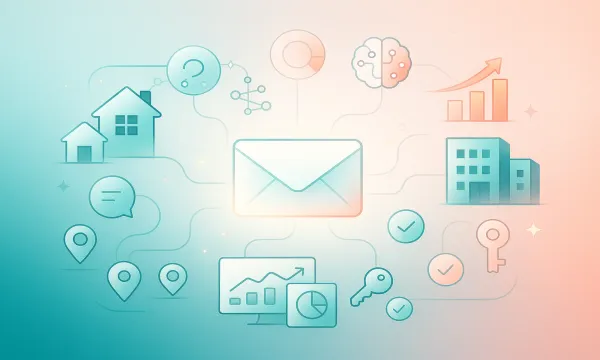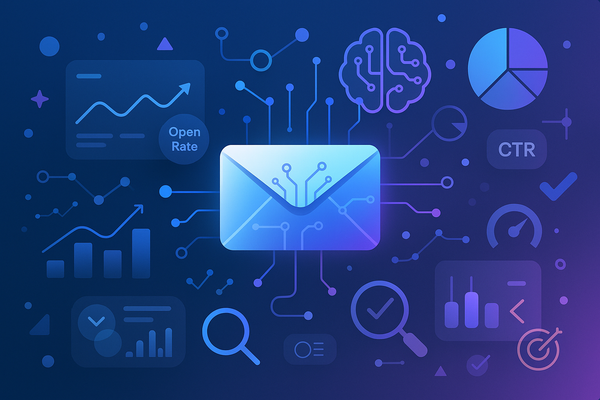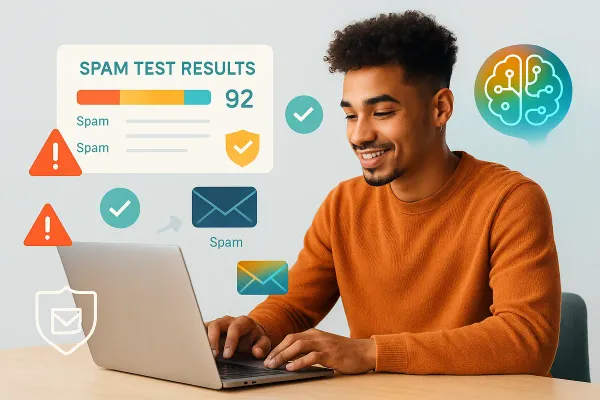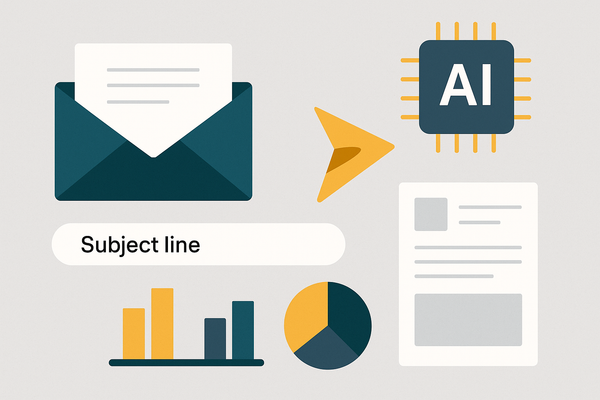Master Email Segmentation Strategies: Complete 2025 Guide
Master email segmentation in 2025 with proven strategies. Complete guide with actionable techniques to boost open rates by 30% and revenue by 760%.
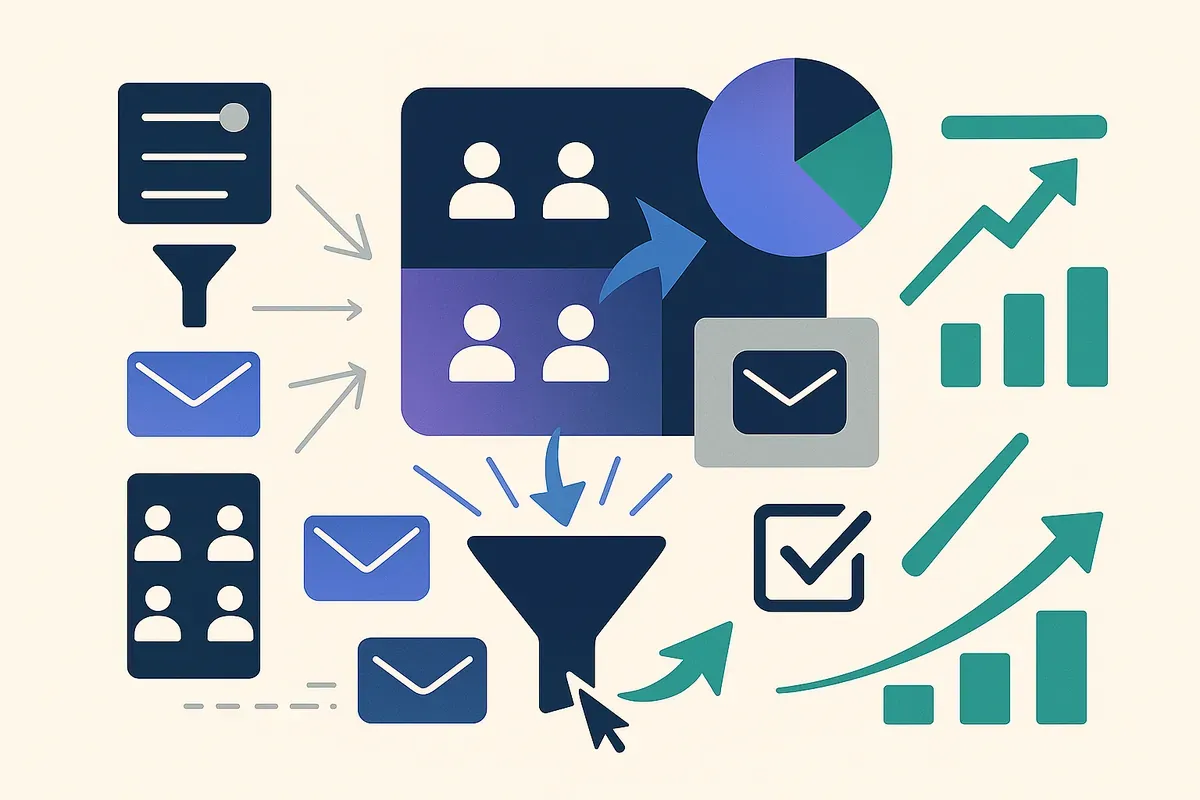
Email segmentation is the practice of dividing your email list into targeted groups based on specific criteria like demographics, behavior, purchase history, and engagement levels. This strategic approach allows you to send personalized, relevant content to each group rather than broadcasting the same message to everyone.
We've helped countless businesses transform their email marketing through strategic segmentation at Groupmail. In our experience, the companies that see the biggest improvements are those who move beyond basic demographics to create behavior-driven segments that reflect how customers actually interact with their brand.
Quick Answer: Email segmentation divides your email list into targeted groups based on demographics, behavior, and engagement. It increases open rates by 30%, click-through rates by 50%, and can boost revenue by 760% because targeted messages feel more relevant and valuable to recipients.
Why Email Segmentation Will Define Success in 2025
Quick Answer: Email segmentation works because it delivers relevant content to specific audience groups, resulting in 760% higher revenue, 30% better open rates, and 50% improved click-through rates compared to generic email campaigns.
According to Campaign Monitor's research, segmented email campaigns drive significantly higher revenue compared to non-segmented campaigns. Industry data shows that marketers have found a 760% increase in email revenue from segmented campaigns.
The competitive advantage is clear:
- Higher Engagement Rates: Mailchimp's comprehensive analysis shows segmented campaigns performed markedly better across all key metrics. When messages feel personally relevant, recipients are significantly more likely to open, click, and convert.
- Improved Deliverability: Email providers favor senders who maintain good engagement rates. When you send targeted content that recipients actually want, you'll see fewer spam complaints and better inbox placement.
- Enhanced Customer Experience: According to industry research, 74% of online consumers get frustrated when content like offers, ads, and promotions are not aligned with their interests.
- Better Resource Allocation: Automated emails generate 320% more revenue than manual campaigns, and segmentation makes automation more effective by ensuring the right messages reach the right people.
💰 Business Impact: 25% of revenue share comes from segmented email lists, with targeted campaigns bringing 30% of total email revenue
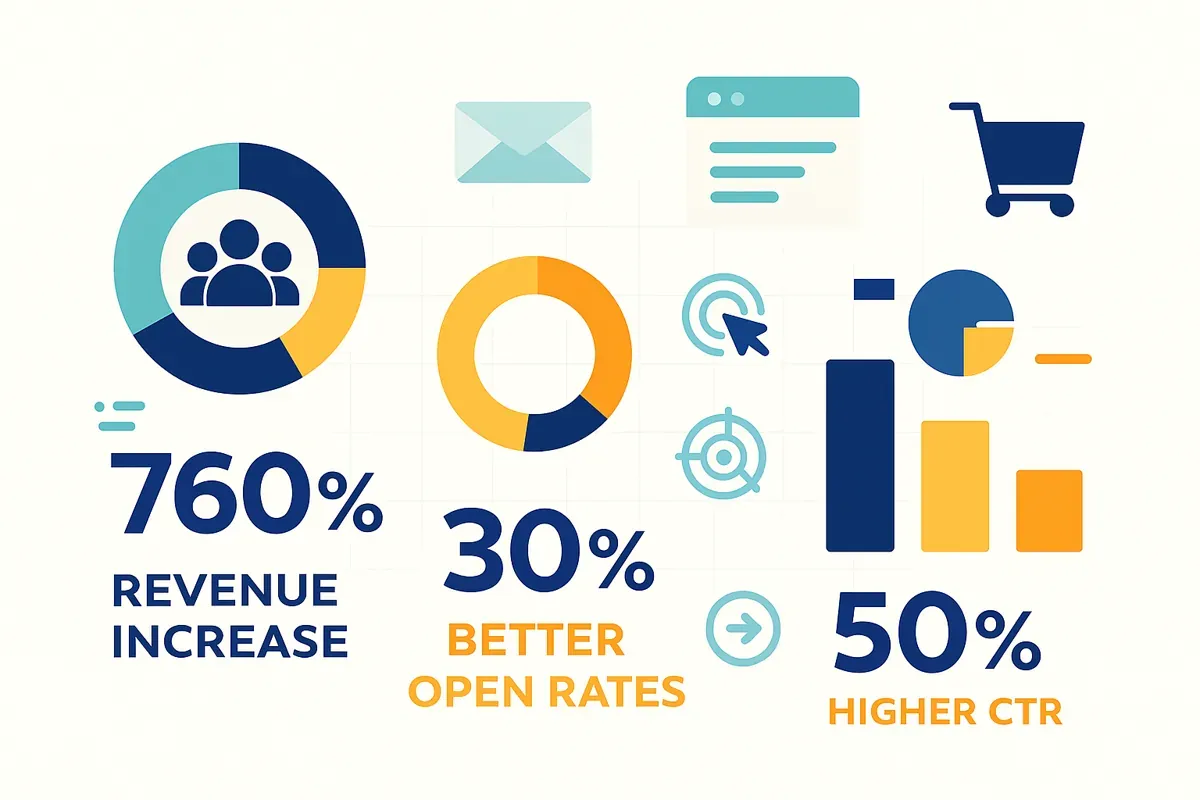
The 7 Essential Email Segmentation Strategies
1. Demographic Segmentation
Quick Answer: Demographic segmentation divides subscribers by age, gender, location, job title, and income level. This creates natural groupings with similar interests, buying patterns, and communication preferences for more targeted messaging.
Demographic data forms the foundation of most segmentation strategies. We recommend starting here because it's relatively easy to collect and provides immediate insights into your audience structure.
Key demographic segments include:
- Age groups - Different generations have distinct communication preferences and purchasing behaviors
- Geographic location - Essential for businesses with location-specific offers or varying shipping zones
- Income level - Helps tailor pricing and product recommendations
- Job title/industry - Particularly valuable for B2B companies
- Gender - Influences product preferences and marketing messaging
At Groupmail, we've seen B2B companies achieve remarkable results by segmenting based on company size and industry. For example, our clients often create separate campaigns for startups versus enterprise customers, with messaging that reflects the unique challenges each group faces.
2. Behavioral Segmentation
Quick Answer: Behavioral segmentation focuses on how subscribers interact with your emails and website, using actual actions like email opens, clicks, website browsing, and content downloads to create high-performing segments.
Behavioral segmentation produces the highest-performing segments because it's based on actual actions rather than assumptions. This data-driven approach often delivers the best results for our clients.
Powerful behavioral segments include:
- Email engagement levels - Highly engaged vs. inactive subscribers
- Website browsing patterns - Which pages and products they view most
- Download and content consumption - What resources they find valuable
- Event participation - Webinar attendees, workshop participants, conference visitors
- Purchase frequency - Regular buyers vs. occasional purchasers
Research shows that brands using behavioral segmentation achieve 14.31% more open rates and 101% more click-through rates compared to non-segmented campaigns.
3. Purchase History Segmentation
Quick Answer: Purchase history segmentation groups customers by what they've bought, spending amounts, purchase frequency, and product categories. This enables highly targeted product recommendations, cross-selling, and retention campaigns.
Your customers' purchase history contains goldmine insights for creating relevant segments. This approach allows you to deliver personalized product recommendations and targeted offers.
Purchase-based segments:
- First-time buyers - Need nurturing and education about your brand
- Repeat customers - Prime candidates for loyalty programs and exclusive offers
- High-value customers - Deserve VIP treatment and premium product recommendations
- Product category buyers - Group by specific products or categories purchased
- Seasonal buyers - Customers who purchase during specific times of year
- Frequency-based groups - Weekly, monthly, or annual purchase patterns
We've found that customers who purchase similar products often have comparable interests and price sensitivities. Creating segments around product categories allows you to cross-sell and upsell more effectively.
4. Customer Lifecycle Stage Segmentation
Quick Answer: Lifecycle segmentation groups subscribers based on their relationship stage with your brand - from prospects to loyal customers - enabling perfectly timed messages for each journey phase.
Understanding where each subscriber sits in their customer journey enables you to deliver perfectly timed messages with relevant content for their specific needs.
Essential lifecycle stages:
- Prospects - Haven't purchased yet but show interest through downloads or engagement
- New customers - Recently made their first purchase and need onboarding
- Active customers - Regular, ongoing purchasers who drive revenue
- At-risk customers - Previously active but showing signs of disengagement
- Win-back targets - Inactive customers you want to re-engage
- Brand advocates - Loyal customers who refer others and leave positive reviews
Each stage requires different messaging strategies. New customers need onboarding and education about your brand, while at-risk customers might respond to special incentives or feedback surveys.
5. Engagement Level Segmentation
Quick Answer: Engagement segmentation divides subscribers based on email interaction frequency - from highly engaged subscribers who open and click regularly to inactive subscribers who rarely engage with your content.
According to industry research, 51% of marketers believe segmenting is the most effective email marketing strategy, and engagement-based segments are among the most actionable.
Engagement tiers we recommend:
- Super engaged - Opens and clicks most emails within 24 hours
- Moderately engaged - Regular opens with occasional clicks
- Low engagement - Sporadic opens, rare clicks
- Inactive subscribers - No engagement for 3+ months
- Re-engagement candidates - Previously active but declining engagement
At Groupmail, we automatically adjust sending frequency based on engagement levels. Highly engaged subscribers can handle daily emails, while low-engagement subscribers might only receive our best content once per week.
📊 Performance Data: Engagement-based segmentation typically improves open rates by 15-25% and click-through rates by 30-50%
6. Geographic and Time Zone Segmentation
Quick Answer: Geographic segmentation includes location-based targeting for climate zones, urban vs rural preferences, time zones for optimal sending, and local events for culturally relevant messaging.
Location-based segmentation goes far beyond just country or state. Consider segmenting by multiple geographic factors for maximum relevance.
Geographic segmentation strategies:
- Climate zones - For seasonal product recommendations and weather-appropriate messaging
- Urban vs. rural - Different lifestyle needs and shopping preferences
- Time zones - For optimal send time scheduling and real-time offers
- Local events and holidays - Regional celebrations and cultural observances
- Economic regions - Areas with similar income levels and market conditions
We've helped clients increase engagement by up to 40% simply by sending emails at optimal times for each geographic segment and tailoring content to local preferences.
7. Preference and Interest Segmentation
Quick Answer: Preference segmentation groups subscribers based on stated interests, content format preferences, communication frequency desires, and product category interests collected through surveys and observed behavior.
This segmentation type relies on both explicit data (what subscribers tell you) and implicit data (what their behavior reveals) to create highly personalized experiences.
Preference-based segments:
- Content format preferences - Video, blog posts, infographics, podcasts
- Communication frequency - Daily, weekly, monthly preferences
- Product interests - Specific categories or features they care about
- Channel preferences - Email, SMS, social media engagement patterns
- Price sensitivity - Budget-conscious vs. premium buyers
- Brand values alignment - Sustainability, innovation, quality focus
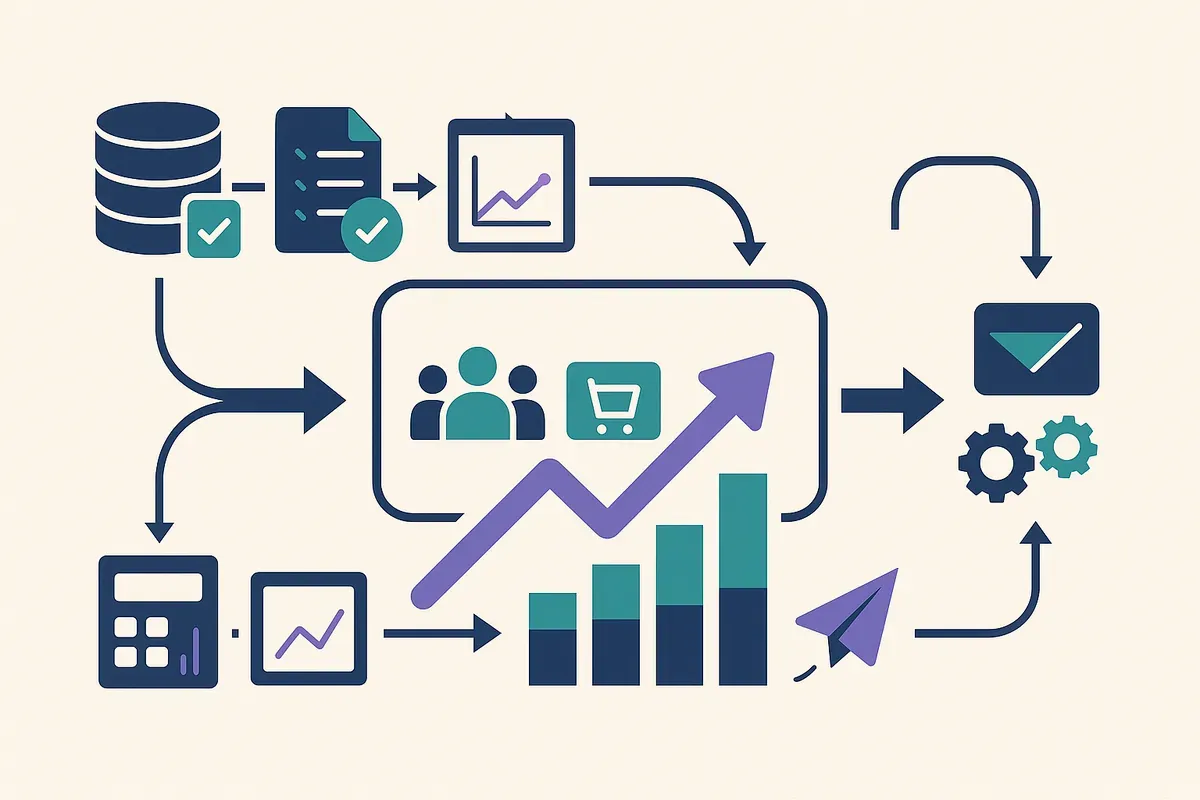
Building Your Email Segmentation Strategy
Data Collection and Management
Quick Answer: Effective segmentation starts with progressive profiling, behavioral tracking, surveys, and purchase data integration. Collect data gradually to avoid overwhelming subscribers while building comprehensive customer profiles.
Effective segmentation strategy starts with quality data. We recommend implementing these data collection methods strategically:
Progressive profiling - Gradually collect information over time rather than overwhelming new subscribers with lengthy forms. Start with just an email address and name, then add one or two fields in subsequent interactions.
Behavioral tracking - Use your email platform's analytics to monitor opens, clicks, and website behavior. Groupmail's campaign analytics make it easy to identify patterns and segment accordingly.
Surveys and preference centers - Ask subscribers directly about their interests and preferences. According to Litmus research, email marketing delivers $36 for every $1 spent when you're sending relevant content based on stated preferences.
Purchase and interaction data - Integrate your email platform with your e-commerce system to automatically segment based on purchase behavior. Learn more about integrating with SendGrid or SMTP2GO for enhanced deliverability.
Creating Your First Segments
Quick Answer: Start with 3-5 basic segments based on engagement level, purchase history, and geographic location. Test these segments against your general list to measure performance improvements before creating complex segments.
Begin with these foundational segments:
- New subscribers (joined in last 30 days)
- Engaged subscribers (opened at least one email in last 30 days)
- Customers (made at least one purchase)
- Inactive subscribers (no engagement in 90+ days)
- Geographic segments (if relevant to your business)
We always recommend starting simple and gradually adding complexity. It's better to have a few well-managed segments than dozens of poorly maintained ones.
Testing and Optimization Framework
Quick Answer: Test segment performance using A/B testing for subject lines, send times, content length, and CTAs. Monitor open rates, click-through rates, conversion rates, and revenue per email to measure success.
| Segment Type | Primary Test Metric | Success Indicator | Secondary Metrics |
|---|---|---|---|
| Engagement-based | Open rates | 15%+ improvement | Time to open, click depth |
| Purchase history | Click-through rates | 25%+ improvement | Conversion rate, AOV |
| Geographic | Conversion rates | 10%+ improvement | Local relevance score |
| Lifecycle stage | Revenue per email | 30%+ improvement | Customer lifetime value |
| Demographic | Engagement rate | 20%+ improvement | Unsubscribe rate |
A/B testing strategies for segments:
- Subject line testing - Different approaches for each segment's interests
- Send time optimization - Based on segment behavior patterns
- Content length experiments - Varying depths for different engagement levels
- Call-to-action variations - Different styles for various customer types
- Personalization levels - Testing degrees of customization
Continuously monitor your segment performance using Groupmail's analytics features to identify which segments drive the best results.
Advanced Segmentation Techniques
Predictive Segmentation with AI
Quick Answer: AI-powered predictive segmentation uses machine learning to identify likely churners, high-value prospects, optimal send times, and content preferences before behaviors manifest, enabling proactive campaign optimization.
AI-powered segmentation is revolutionizing email marketing. According to recent studies, 51% of marketers are already using AI for segmentation, with predictive capabilities becoming increasingly sophisticated.
Advanced email platforms now use machine learning to predict subscriber behavior and create dynamic segments:
- Churn prediction - Identifies subscribers showing early signs of disengagement
- High-value prospect identification - Spots new subscribers with characteristics similar to your best customers
- Optimal timing prediction - Determines individual-level send times for maximum engagement
- Content preference modeling - Predicts what type of content each subscriber will click
- Purchase likelihood scoring - Ranks subscribers by probability to buy specific products
For insights into implementing AI in your email strategy, explore our guide on AI email marketing tools.
Dynamic Segmentation
Quick Answer: Dynamic segmentation automatically moves subscribers between segments based on real-time behavior changes, ensuring segments stay current and relevant without manual updates.
Rather than static segments that require manual updates, dynamic segmentation automatically moves subscribers between segments based on their evolving behavior patterns.
Examples of dynamic segment rules:
- Spending thresholds - Automatically move customers to "VIP" segment after reaching $500 in purchases
- Engagement triggers - Shift subscribers to re-engagement campaigns after 60 days of inactivity
- Lifecycle progression - Move new subscribers to "active customer" segment after first purchase
- Seasonal adjustments - Automatically tag seasonal buyers during relevant periods
- Content engagement - Group subscribers based on their content consumption patterns
Micro-Segmentation Strategy
Quick Answer: Micro-segmentation combines multiple criteria to create highly specific customer groups, such as "urban millennial women who purchased eco-friendly products in the last 30 days and clicked three recent emails."
Instead of broad segments like "women aged 25-35," micro-segmentation creates laser-focused groups by combining multiple data points: "urban millennial women who've purchased eco-friendly products in the last 30 days and clicked on your last three emails."
Micro-segmentation examples:
- Behavioral + demographic - "Male subscribers aged 30-40 who browse electronics and open emails on weekends"
- Purchase + engagement - "High-value customers who buy quarterly and prefer video content"
- Geographic + interest - "West Coast subscribers interested in outdoor activities"
- Timing + preference - "Morning email openers who prefer short, actionable content"
While these segments may be smaller, they often produce higher engagement and conversion rates due to their precision.
🎯 Precision Marketing: Micro-segments of 50-100 highly targeted subscribers often outperform broad segments of 1,000+ subscribers in conversion rates
Legal and Compliance Considerations
GDPR and Email Segmentation
Quick Answer: GDPR requires explicit consent for data collection, clear explanations of segmentation use, easy opt-out mechanisms, data access rights, and retention policies for compliant email marketing.
The GDPR requires organizations to protect personal data in all its forms, and this extends to how you collect and use data for segmentation compliance. According to official GDPR guidance, processing is only allowed if either the data subject has consented, or there is another legal basis.
GDPR compliance requirements for segmentation:
- Explicit consent - Obtain clear permission for data collection and segmentation use
- Transparency - Clearly explain how segmentation data will be used in privacy policies
- Access rights - Allow subscribers to view and update their segment data
- Opt-out mechanisms - Provide easy ways to unsubscribe from specific segments
- Data retention policies - Delete segmentation data when no longer needed
- Processing purpose limitation - Use data only for stated segmentation purposes
According to GDPR compliance experts, email marketing strategies underwent significant changes post-GDPR, but segmentation remains effective when done transparently and with proper consent.
CAN-SPAM Compliance
Quick Answer: CAN-SPAM requires accurate sender information, clear unsubscribe options, honoring opt-out requests within 10 days, avoiding misleading subject lines, and including physical business addresses in all segmented campaigns.
The CAN-SPAM Act sets the rules for commercial email and applies to all segmented campaigns. According to FTC guidance, each separate email in violation can result in penalties of up to $53,088.
CAN-SPAM requirements for segmented campaigns:
- Accurate sender information - Use truthful "From," "To," and routing information for all segments
- Clear unsubscribe options - Include prominent opt-out mechanisms in every email
- Prompt opt-out processing - Honor unsubscribe requests within 10 business days
- Honest subject lines - Avoid misleading headers, even in targeted campaigns
- Physical address disclosure - Include your business address in all emails
- Commercial identification - Clearly identify commercial messages as advertisements
At Groupmail, we ensure all our segmentation features are designed with compliance in mind, making it easy for you to maintain legal email marketing practices.
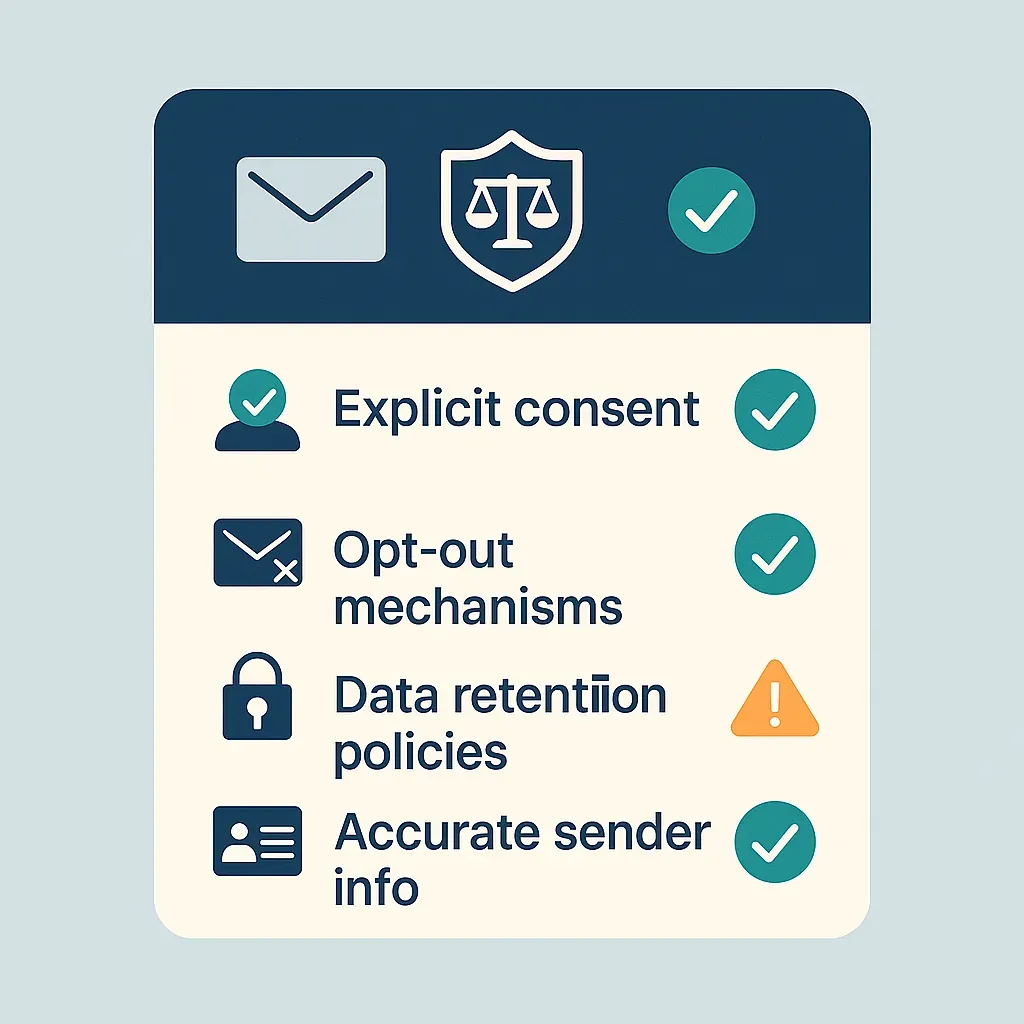
Measuring Segmentation Success
Key Performance Indicators
Quick Answer: Track open rates, click-through rates, conversion rates, and revenue per email for each segment. Compare these metrics against non-segmented campaigns. Aim for 15%+ improvement in open rates and 25%+ improvement in click-through rates.
Essential segmentation metrics to monitor:
| Metric | Calculation Formula | Good Performance | Industry Benchmark |
|---|---|---|---|
| Segment Open Rate | (Opens ÷ Delivered) × 100 | 25%+ | Varies by industry |
| Segment CTR | (Clicks ÷ Delivered) × 100 | 3%+ | 2.5% average |
| Conversion Rate | (Conversions ÷ Clicks) × 100 | 2%+ | 1-3% typical |
| Revenue per Email | Total Revenue ÷ Emails Sent | $0.50+ | Industry-dependent |
| List Growth Rate | (New - Unsubscribes) ÷ Total × 100 | 2-5% monthly | 2% average |
| Segment Health Score | Engagement Rate + Growth Rate | 15%+ | Custom metric |
Analyzing Segment Performance
Quick Answer: Conduct monthly segment performance reviews comparing segments against overall averages, tracking lifetime value by segment, monitoring size changes, and analyzing cross-segment movement patterns.
Regular segment analysis should include:
- Performance benchmarking - Compare each segment against overall list averages
- Lifetime value tracking - Identify which segments drive highest customer value
- Segment size monitoring - Track growth or decline in segment populations
- Cross-segment movement analysis - Understand how subscribers transition between segments
- Content performance by segment - Determine what content resonates with each group
- Revenue attribution - Calculate revenue contribution by segment
💰 Revenue Impact: According to industry research, marketers who segment email lists increase email marketing revenue by 760%
We recommend reviewing segment performance monthly and making adjustments based on data trends rather than assumptions. For detailed analytics guidance, learn about email analytics that actually matter.
Advanced Analytics and Reporting
Sophisticated segmentation analysis includes:
- Cohort analysis - Track segment performance over time
- Attribution modeling - Understand segment impact on overall business goals
- Predictive lifetime value - Forecast long-term segment value
- Engagement scoring - Create composite scores for segment health
- Competitive benchmarking - Compare segment performance against industry standards
Common Segmentation Mistakes to Avoid
Over-Segmentation Pitfalls
Quick Answer: Avoid creating too many small segments (under 100 subscribers each) as this leads to insufficient data for testing, content creation overwhelm, management complexity, and reduced campaign effectiveness.
While granular segments can be powerful, over-segmentation creates significant challenges:
- Statistical insignificance - Segments under 100 subscribers lack meaningful data
- Content creation overwhelm - Too many segments require excessive content variations
- Management complexity - Difficult to maintain and optimize numerous segments
- Resource dilution - Spreading efforts too thin across many small groups
- Testing limitations - Small segments prevent reliable A/B testing
Best practice: Ensure each segment has at least 100 subscribers for meaningful results and statistical significance.
Under-Utilizing Available Data
Quick Answer: Many businesses collect valuable segmentation data but fail to use it effectively. Common missed opportunities include website behavior, email engagement patterns, customer service interactions, and social media engagement data.
Many businesses collect extensive data but fail to leverage it for segmentation. Common missed opportunities include:
- Website browsing behavior - Page views, time on site, product interests
- Email engagement patterns - Open times, click patterns, content preferences
- Customer service interactions - Support tickets, satisfaction scores, issue types
- Social media engagement - Platform preferences, content sharing, interaction levels
- Survey responses - Feedback data, preference information, satisfaction ratings
- Mobile app behavior - Usage patterns, feature preferences, session duration
Neglecting Segment Maintenance
Quick Answer: Segments require ongoing maintenance including removing inactive segments, merging similar performers, updating criteria based on business changes, and refreshing data sources regularly.
Segment maintenance is critical for long-term success. Subscribers' needs and behaviors change over time, requiring regular attention:
- Regular audits - Quarterly reviews of segment performance and relevance
- Data refresh - Update segment criteria based on new behavioral patterns
- Merge similar segments - Combine segments that perform identically
- Remove inactive segments - Eliminate segments that no longer serve business purposes
- Criteria updates - Adjust segmentation rules based on business evolution
- Technology updates - Leverage new platform features for better segmentation
For small businesses getting started with segmentation, check out our guide to the 7 best email marketing tools for small business.
Frequently Asked Questions
What's the minimum list size needed for effective segmentation? You can start segmenting with as few as 500 subscribers, but we recommend waiting until you have at least 1,000 subscribers to create meaningful segments of 100+ people each for statistical significance.
How many segments should I create initially? Start with 3-5 basic segments based on engagement, purchase history, and demographics. Add more segments gradually as you gain experience and data. Avoid over-segmentation that dilutes your efforts.
Should I segment B2B and B2C emails differently? Yes. B2B segmentation should focus more on company size, industry, job role, and business needs, while B2C typically emphasizes demographics, purchase behavior, lifestyle preferences, and personal interests.
How often should I review and update my segments? Review segment performance monthly and conduct comprehensive audits quarterly. Update segment criteria as your business and customer base evolves. Regular maintenance ensures segments remain relevant and effective.
Can segmentation work with small email lists? Small but strategic segments drive impressive results. According to industry data, automated emails relying on segmentation made up just 2% of total email volume but generated 37% of all email-driven sales.
What's the biggest mistake in email segmentation? The biggest mistake is creating segments but not tailoring your content to each group. Segmentation without personalized messaging delivers minimal improvements. Content relevance is key to segmentation success.
How do I handle subscribers who fit multiple segments? Prioritize segments by business impact and customer value. A customer might be both "high-value" and "inactive," but the high-value segment might take priority for retention campaigns. Create hierarchy rules for segment assignment.
Should I tell subscribers they're in specific segments? Generally no, but transparency about data usage builds trust. Consider explaining your personalization approach in your privacy policy rather than mentioning specific segments. Focus on the value they receive from relevant content.
Getting Started with Email Segmentation Today
Email segmentation transforms generic email blasts into targeted, valuable communications that your subscribers actually want to receive. The statistics speak for themselves: according to industry research, 25% of revenue share comes from segmented email lists, and sending targeted emails to these segments brings 30% of total email revenue.
Your immediate action plan:
- Audit current data - Review your existing subscriber data to identify available segmentation criteria
- Start simple - Create 3-5 basic segments: new subscribers, engaged users, customers, and inactive subscribers
- Create targeted content - Develop specific messaging for each segment that addresses their unique needs and interests
- Test and measure - Compare segment performance against your general list to measure improvements
- Scale gradually - Add more sophisticated segments as you gain experience and collect additional data
- Maintain regularly - Schedule monthly reviews and quarterly audits to keep segments relevant
Remember, successful email marketing segmentation isn't about creating the perfect system overnight. It's about continuously improving how well you understand and serve your subscribers' needs.
Key Takeaway: Email segmentation isn't just a technical feature—it's a customer-centric approach that shows subscribers you understand their individual needs. Start simple, measure everything, and let your data guide your strategy for maximum impact.
Ready to implement effective segmentation? Try Groupmail's drag-and-drop builder free—unlimited sending included. Our built-in segmentation tools make it easy to create targeted campaigns that drive real results. You can also enhance your campaigns with our free AI subject line generator to boost open rates even further.
Start creating professional email campaigns with Groupmail's free account—no credit card required. Access unlimited sending and our live AI subject line generator today. For more insights into AI-powered email marketing, explore how AI is revolutionizing email marketing in 2025.

